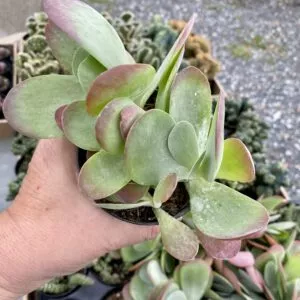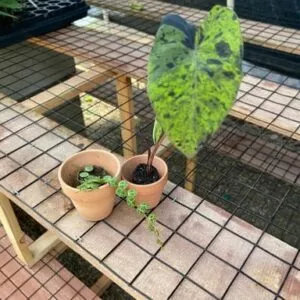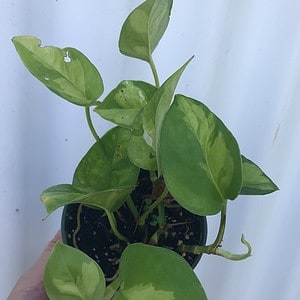No products in the cart.
Table of Contents
A classic favorite in most American shade gardens is the Rhododendron hybrid. This plant creates a focal point in the landscape. The specimen’s plants are breathtaking along fences and walls.
It also makes it an excellent choice for foundation plantings or hedges. The most featured out of the lot is the PJM Rhododendron, which stands for Peter J Mezitt. Today we will look at these exceptional winter hardiness plants and how you can care for them.
More About The Rhododendron Hybrids
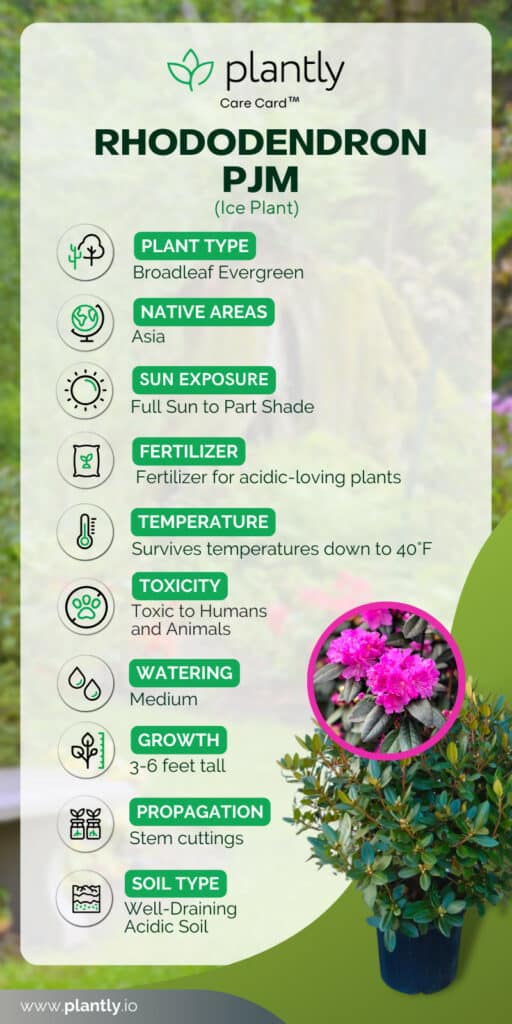
The Rhododendron PJM is exceptionally hardy with vigorous yet showy growth, classified as an evergreen shrub. During mid to late spring, you see a display of rounded clusters of up to 15 trumpet-shaped reddish-purple flowers.
The dark green leaves have an elliptic yet glossy reddish-purple color from fall to winter. It is a reliable performer and tough to withstand very low cold temperatures. The majority of hybrids are a cross between the Rhododendron family.
The hybridization of these plants started way back in 1930 with Peter J Mezitt and his son Edmund. The plant grows well in shade gardens, as foundation plantings, for their showy flowers.
You can find some of the hybrids with lavender-pink flowers displayed in shrub borders. The plant grows in a dense rounded form up to six feet tall and wide and is a partial shade lover that grows well in humusy soil. It needs to be planted shallowly in a location protected from the winter winds.
Another major attraction is that Rhododendron attracts butterflies, and birds, to hummingbirds, and when the flowers fade, you remove them to promote new growth.
PJM Rhododendron Care
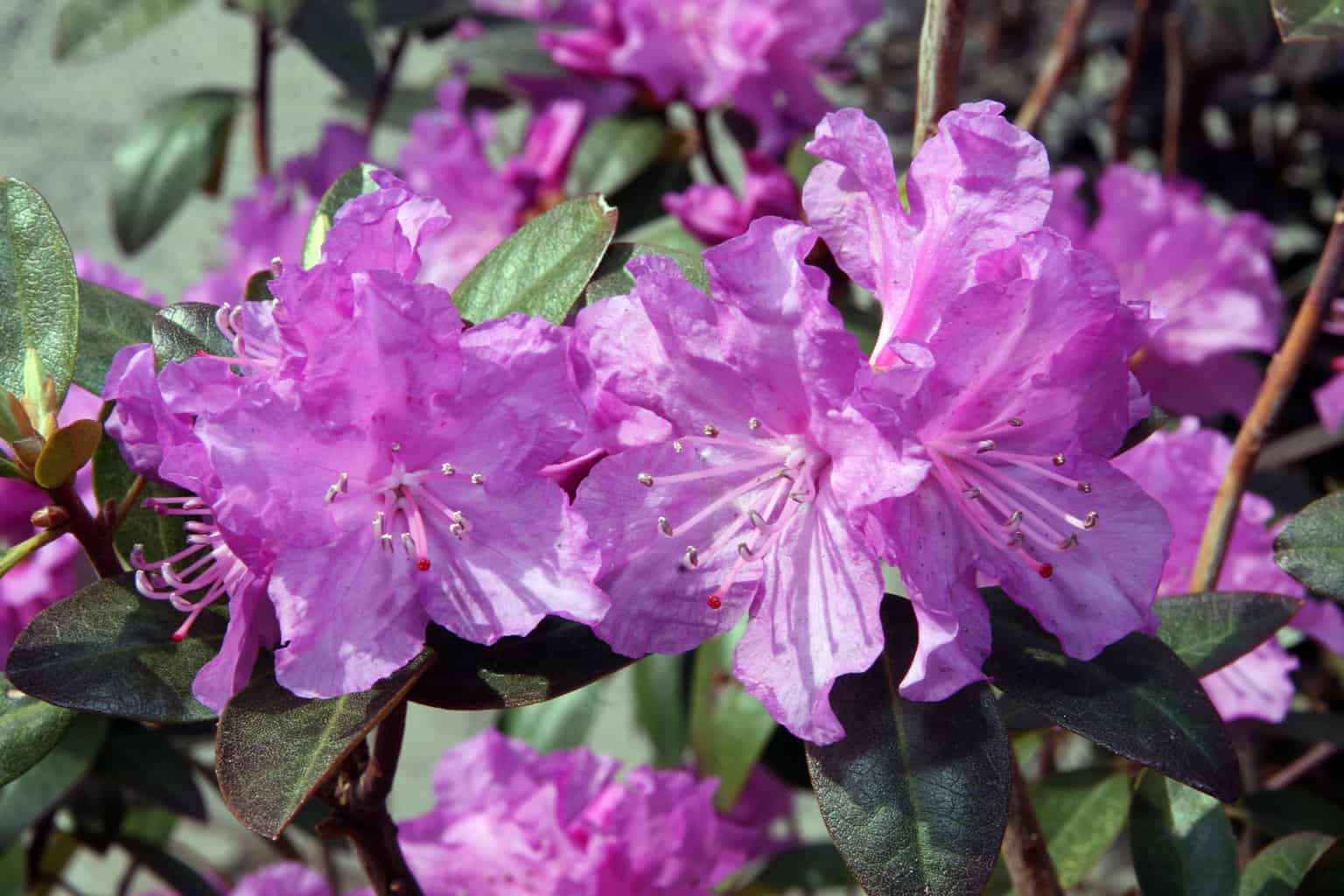
The best time to plant Rhododendrons is from early spring to early fall to give your plants a great start. Whether planted in mixed borders, shrub borders, or containers, it needs special care to keep it thriving.
Planting Rhododendron as Foundation Plantings or in Shade Gardens
Growing Rhododendron helps choose a location that allows the root ball to spread and branch. We recommend spacing plants wide apart and far from the foundation of buildings. Doing this allows your plant’s foliage to grow without getting crowded.
Start digging a hole deep enough for the root ball to be three times wider. Once removing the soil, helps to mix in some peat moss or compost as it helps enrich the soil and loosen it up. Next, remove the plant from the pot you received it in and set your plant in the hole and remember to remove the burlap.
Also gently tug the roots apart using your fingers. Now, fill the hole with soil until the roots fall from the main stem. Water well and add a layer of mulch using shredded bark around the area. But keep the mulch away from the plant’s trunk.
Having the mulch too close to the stem can result in crown rot. Another helpful tip is to mulch annually.
The Best Lighting for Rhododendron Plants Evergreen Leaves
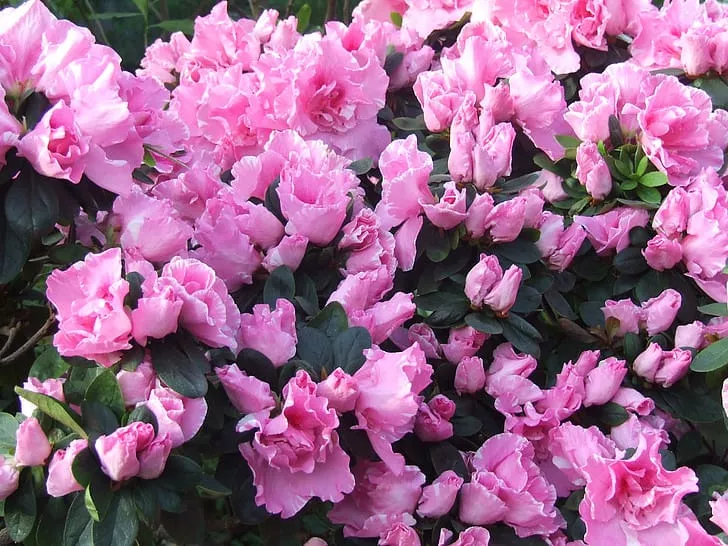
Whether planted in the garden or container, it helps provide your Rhododendron hybrids with proper lighting. We recommend a spot with partial shade sheltered from the full sun. Still, keeping your plants in full shade, strong winter winds, or frost is not advised.
These can leave the Rhododendron hybrids resulting in leaf scorching or splitting of the beautiful evergreen foliage. Inside the home growing your plant in pots, it helps to provide them with partial sun to keep the deep green foliage looking great.
Choose Well Drained Soils for New Plants
When asking, “How to care for Rhododendrons and soil?” they need well-drained, acidic soil. In addition, it helps to use organic-rich soil that can retain moisture, is fertile, and drains well. These conditions are essential for your plant to thrive.
If you have a more alkaline soil ph, we recommend planting them in containers. The reason is that soil ph you cannot reduce as a neutral ph soil that is not acidic will not provide your plant with the iron needed for the leaves to be chlorotic.
Rhododendron planting needs soil moisture but is not waterlogged as it can lead to root rot. Hence well-drained soil in a container with enough drainage holes is essential.
Watering The PJM Group
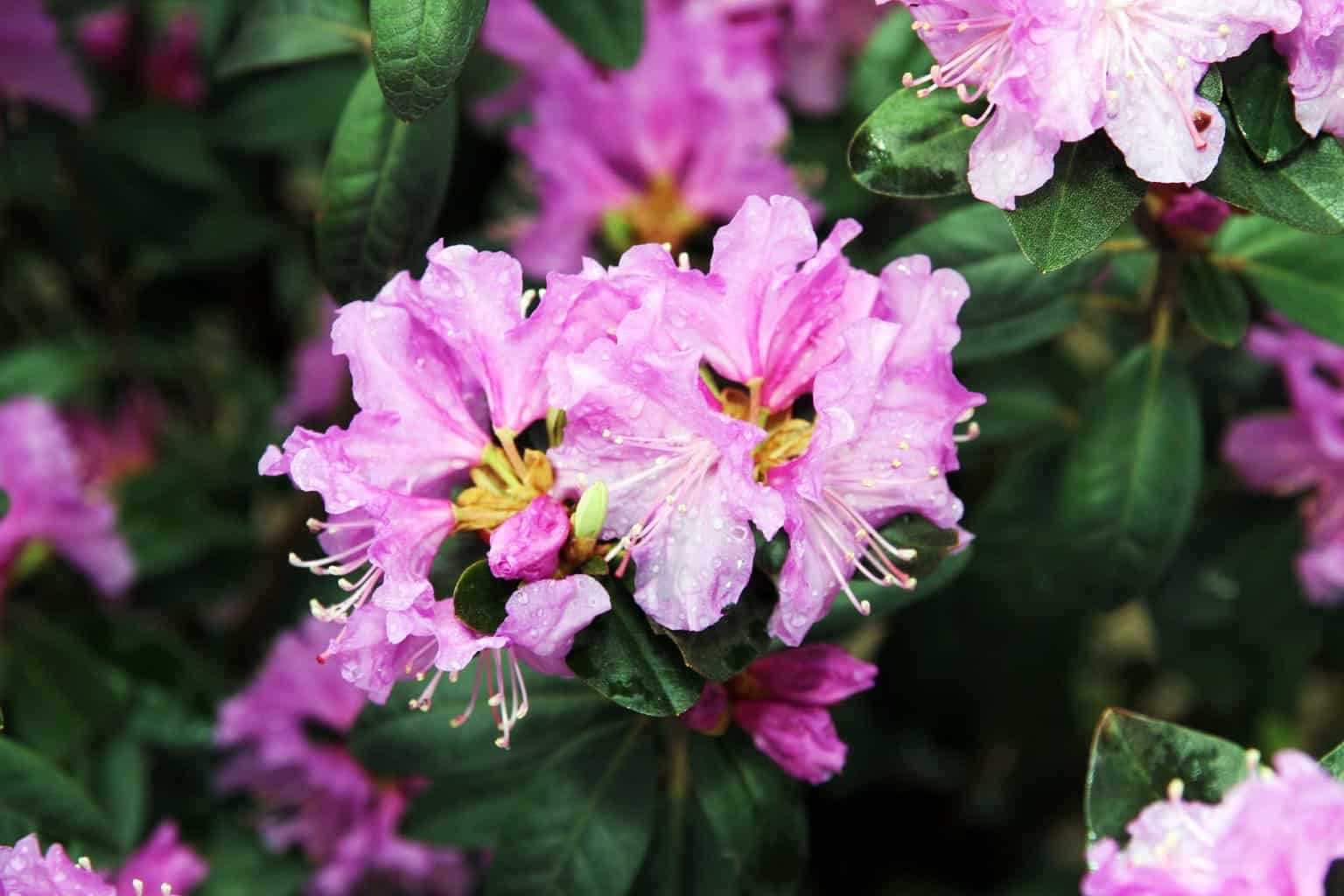
Depending on where you plant your PJM Group, an important thing is not to overwater. Instead, it helps to consider outdoor rainfall; new plants need watering weekly in the first growing season.
The growth habit of Rhododendron is broad, and a slow hour of water trickle will do the job fine. When warm, it will help to soak your Rhododendron well, as it does not like dry spells. Deep watering helps new roots develop and grow further into the ground, providing you with sturdier plants.
We recommend checking the soil moisture between watering indoor and outdoor plants.
Fertilizing Rhododendron PJM
Fertilization must be done carefully as the root ball is delicate and can easily be damaged. We recommend a light feed for acidic plants added to the surface before you apply mulch. Fertilizing can be done from early spring to midsummer during the growing season.
Temperature and Humidity

The Rhododendron remains a hardy plant that can flourish in cool temperatures, providing it has some mulch protection to retain moisture and protect the root ball. These plants flourish in zones 5 to 8, and some varieties can withstand more chills or heat.
Hence they prefer cooler temperatures and low humidity compared to other plants.
Pruning Your PJM Rhododendron
While it is not recommended to prune your trees after removing them from the container, light pruning will provide them with shape. In addition, you can remove the broken branches and thin out your branched plant before transplanting it to the garden.
The best time to prune your evergreen is in May and June, and it helps to snap off the spent flowers to prevent seed production.
Propagating Rhododendron
When you look at the Rhododendron family, has similar propagating techniques to your Azaleas to broaden your collection through stem cuttings. It is essential to propagate varieties with smaller leaves as they tend to root quickly.
Prepare your growing medium of half perlite, half peat moss, and commercial potting soil.
Mix the soil in a plant pot depending on how many cuttings you plan to work with.
Take a clean, sharp blade, choose a young branch with light colors without a bud, and cut across the branch about six inches from the tip.
Remove the lower leaves and bud, if it has one, and remove the bark at the base.
Dip the cut end in some rooting hormone and place that end in the potting mix.
Place your plant in a warm spot and keep the soil moist.
Alternatively, keep the pot covered with a plastic bag and remove it daily to water.
Rhododendron PJM Varieties
In the PJM Group tree collection, you can find some varieties to grow together. Here are some of our favorites.
PJM Compact
The plant is similar to the PJM Rhododendron but grows a larger flower and has an upright to spreading growth habit.
PJM Compact Briggs
The plant has a smaller habit of growing with a flower color of lavender pink.
PJM Lavender
This plant displays lavender-pink flowers, an early flowering tree with reddish-brown winter leaves, and a semi-dwarf tree.
PJM White Form
As you guessed, it is an evergreen green with a white flower.
Common Pests and Diseases
Rhododendrons are susceptible to disease and insects. It would help if you kept an eye on mealybugs, aphids, lace bugs, borers, nematodes, scales, whitefly, thrips, and caterpillars.
Some concerns with the disease are leaf spots, blights, crown rot, root rot, rust, powdery mildew, and canker.
Frequently Asked Questions
It helps to prune your PJM Group in summer after the flowers fade and the bloom cycle ends. You can remove dead branches and cut them back to give them a tidy shape. We recommend regaining from trimming in fall or winter as it will prevent buds from developing the following growing season.
We recommend growing your plant in well-drained soil in part shade instead of full shade or full sun. Some species can develop in bright sunlight, but most are not drought-tolerant. Also, protect them from strong winter winds and only keep the soil moist.
These species can cultivate from three to six feet wide to display their lavender-pink flowers in bloom time.
The good news is that the PJM group are not rare plants found at local nurseries to buy as seedlings or in the form of seeds. But instead of heading out of the comfort of your home, you see this gorgeous species here at Plantly.
Whether you want to buy, sell or simply reach out to other plant enthusiasts, Plantly is the right place to be!
In stock Only 1 left in stock In stock In stock
$23.00
Sold By:
Smoot's Farm
Succulent Flapjack or Paddle Plant or Kalanchoe thyrsiflora 3″ Po
Rated 4.89 out of 5 based on 27 customer ratings00
Sold By:
Smoot's Farm
$40.99
Sold By:
Succulent Oasis
Large Succulent Plant Ponytail Palm or Beaucarnea Recurvata.
Rated 4.84 out of 5 based on 352 customer ratings00
Sold By:
Succulent Oasis
$24.95
Sold By:
Wonka Plants
$26.00Colocasia – Mojito – Starter Plant
Only 23 available and it’s in 3 people’s basket Rated 4.94 out of 5 based on 108 customer ratings39
Sold By:
Wonka Plants
$13.95
Sold By:
SunSoul Plants
$23.95Global Green Pothos, Epipremnum Aureum in 3″ pot
Only 2 available and it’s in 1 people’s basket Rated 4.87 out of 5 based on 98 customer ratings00
Sold By:
SunSoul Plants
